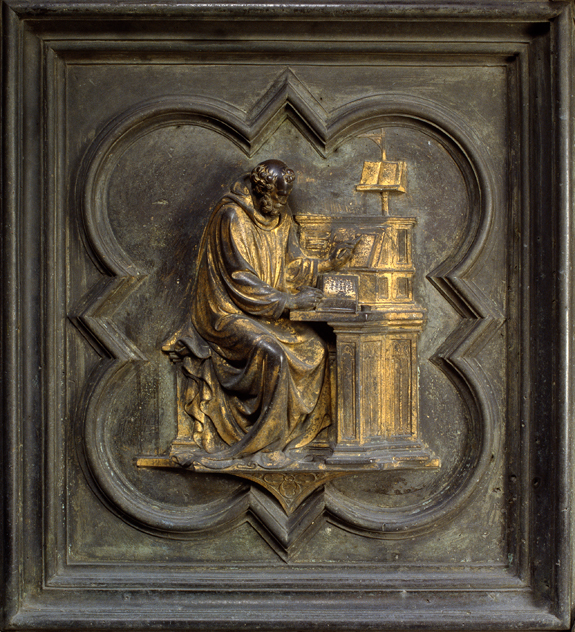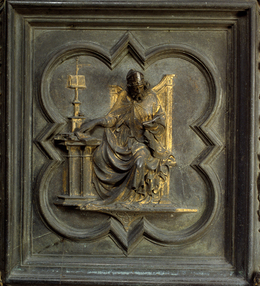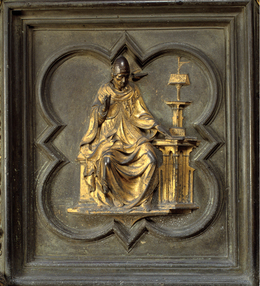Panel XXVI - Jerome
Panel details:
“ seek to learn on earth those truths which will remain ever valid in heaven ”. St Jerome to St Paulinus of Nola (ep. 53, 10)
Sofronius Eusebius Hieronymus, the latin name for Jerome, was born into a Christian family in Stridon (Croatia) in 347 AD. Jerome’s family provided him an excellent education and also sent him to Rome to complete his studies under Aelius Donatus. as a young man, he was attracted by the worldly life, however, his desire for and interest in the Christian religion prevailed.
Jerome was baptized at the age of 25 (around 366) and was ordained a priest when he was 38 years old. After he finished his studies in rhetoric, he retreated to trier, where saint Athanasius taught Egyptian anchoritic asceticism for a few years during his exile.
Jerome then travelled to Aquileia where he joined a community of ascetics, which he defined “almost...a choir of blesseds”, under the patronage of archbishop Valerian. The animosity, though, which had arisen among the ascetics disappointed and disturbed him terribly; therefore, he soon decided to leave for the east. He travelled to the desert of Chalcis, south of Aleppo, where he lived the arduous life of the hermit for about two years (375-376). During that period of time, he studied assiduously, perfecting his knowledge of Greek, began learning Hebrew and transcribing codices and patristic writings.
Meditation, solitude and communication with the word of God facilitated the evolution of his Christian sensibility.
During his ascetic retreat, Jerome deeply regretted the indiscretions of his youth (cf. ep. 22, 7) and was keenly aware of the contrast between pagan mentality and Christian life. He left us the famous, vivid but dramatic account of the “vision” of this conflict, in which it seemed to him that he was being scourged before God because he was “Ciceronian rather than Christian” (cf. ep. 22, 30).
Numerous artists have been inspired by this period of his life, representing Jerome as the penitent. The legendary episode of the lion also dates to this period. The episode narrates that a lion was suffering terribly because it had a thorn in its paw; Jerome removed it and the lion stood by him in gratitude. Traditionally, Jerome has also been depicted flailing himself repeatedly with a rock to inflict penance. Jerome was once again distressed by the disputes among the hermits, divided by the Arian doctrine, and consequently returned to Antioch, where he had stayed before going to Halkida. He remained in Antioch until 378, attending classes held by Apollinaris of Laodicea and where bishop Paulinus of Antioch ordained him priest.
He then travelled to Constantinople, where under the guidance of the bishop Gregory Nazianzen (one of the Cappadocia fathers) he completed his studies of Greek. It was during this sojourn that he read the texts of origen and Eusebius.
When Gregory Nazianzen left Constantinople in 382, Jerome returned to Rome. He was appointed secretary to pope Damasus I and was considered his most likely successor. Here, a group of virgins and widows had formed, led by a certain noblewoman Marcella and the wealthy widow Paula, accompanied by her daughters Julia Eustochia and Blesilla, whose sole desire was to devote themselves to an ascetic life consisting of prayer, meditation, abstinence and penance. Jerome became their spiritual father.
The moral rigor which Jerome adhered to, favouring the introduction of ecclesiastical celibacy and the eradication of the so-called Agape Phenomenon (Christian virgins who individually consecrated their lives to God through a vow of chastity) was not well accepted by most of the clergy that agreed almost entirely with jovinian thought, which denied the perpetual virginity of Mary). When pope Damasus I died, the Roman Curia intentionally and effectively contrasted the election of Jerome to the pontifical throne, among other reasons, attributing him responsibility for the death of his disciple Blesilla. Blesilla was a noble roman woman in her twenties who belonged to the gens Cornelia and had been widowed at a very young age. She had followed her mother Paula and sister Julia Eustochia together with a group of women who had decided to pursue the monastic life, following the strict rules Jerome set forth. She unfortunately died, likely due to too many fasts. The exceptional case raised uproar, due to the enormous popularity Blesilla’s family enjoyed. Jerome’s opponents claimed that his theories regarding corporal mortification were simply acts of fanaticism, whose negative effects led to the untimely death of Blesilla. The deacon Siricius was elected pope in his stead at the end of 384.
In August of 385, Jerome embarked from Ostia to return to the east together with his brother Paolinian, the priest Vincent and several monks loyal to him, where he persevered his battle in favour of clerical celibacy. Shortly after their departure, his disciples Paula and Julia Eustochia together with other members of the Roman female community of ascetics followed them. through the generosity of the wealthy widow, Paula, Jerome founded a female monastery and a male one in Bethlehem, where he lived until his death. he continued his prodigious writings dedicated to the translation of the bible, commentaries on the word of God, defending the faith, vigorously opposing heresies and exhorting monks to perfection. He taught classical and Christian culture to young students and welcomed pilgrims who visited the holy land with the spiritual aura of a pastor. Jerome dedicated the post mortem epitaphium sanctae Paulae to his disciple Paula who died in 404 (subsequently venerated as a saint). He died in his cell close to the Grotto of the nativity, on September 30th, 419 or 420, the very year in which celibacy, after being completely ignored for a very long time was imposed on the clergy by the law emperor honorius decreed.
St Jerome is a father of the Church who centred his life on the Bible, which he translated into Latin; he wrote commentaries and above all strove to live according to its teachings in his long earthly existence, despite the well-known inflexible character and fiery personality nature endowed upon him. Jerome’s excellent literary studies and vast erudition enabled him to revise and translate many biblical texts - an invaluable work for the Latin Church and for western culture. he revised the four gospels in Latin, the Psalter and a large part of the Old Testament, basing his writings on the original texts in Greek and Hebrew as well as comparing previous versions. Through comparing and cross-referencing the original Hebrew and Greek texts of the septuagint, the classical Greek version of the Old Testament dating back to the pre-Christian era, as well as the earlier Latin versions Jerome, together with the assistance of collaborators, yielded/provided a better translation. This constitutes the so-called “vulgate”, the “official” text of the Latin Church which was recognized as such by the council of Trent and which, even after a recent revision, continues to be the “official” Latin text of the Church. It is interesting to observe the criteria the great biblical scholar employed when translating. regarding the philological translation he diligently respected the order of the words of the sacred scriptures, for in them, he says, “even the order of the words is a mystery”; that is, a revelation. He further reaffirms the need to refer to the original texts: “should an argument on the New Testament arise between Latins because of interpretations of the manuscripts that fail to agree, let us turn to the original, that is, to the Greek text in which the new testament was written. Likewise, with regard to the Old Testament, if there are divergences between the Greek and Latin texts we should have recourse to the original Hebrew text; thus, we shall be able to find in the streams all that flows from the source”. Jerome also commented on many biblical texts. According to him, commentaries must offer multiple opinions, “so that the shrewd reader, after reading the different explanations and hearing many opinions — to be accepted or rejected — may judge which is the most reliable, and, like an expert moneychanger, may reject the false coin”. Jerome energetically and vigorously refuted the heretics who contested the tradition and faith of the church. Additionally, he demonstrated the importance and validity of Christian literature, which had become a true culture that deserved to be positioned on the same level as classical literature, in his work “De Viris illustribus”, which contains biographical notes of more than a hundred Christian authors. He wrote biographies of monks, illustrating the monastic ideal paralleled to other spiritual paths; he translated several works by Greek authors and composed the important epistulae, a masterpiece of Latin literature.
Christians and all cultures throughout time are indebted to Jerome. He was polemic, and often in vehement disaccord with scholars, saints, sinners and the unprepared; he was greatly admired as well as intensely hated. He remains, though, a benefactor of intelligence and the Church venerates him as one of its greatest fathers. His relics, after various journeys and events, are now kept in the porphyry urn of the papal altar in the Basilica of Santa Maria Maggiore in Rome. One of his relics is in the Church of st Onofre on the Janiculum in Rome. The iconography of Jerome has changed over the centuries, acquiring diverse connotations such as, being depicted in cardinal vestments or as a hermit, including attributes such as the skull (typical of the holy penitents), the stone (object for his bodily penance), the lion (the legend in which he was protagonist during his asceticism), the book (representing his illustrious theological works). St. Jerome is represented in three main portrayals: a scholar in his study, related to the early representations of the evangelist sitting at a desk or in front of a lectern in a domestic environment and landscape in the background; a hermit and doctor of the church.
In the thirteenth century the iconography was enriched with additional attributes. The “Golden legend” painted by the dominican monk, Jacopo Da Varazze gave more space to the marvellous and legendary elements. In 1340, another dominican, Petrus De Clugia, wrote “De sancto Hieronymo” referring to most of his previous texts, while Peter De Natalibus was inspired by Jerome’s writings in his chapter entitled “De sancto hieronymo presbytero et doctore”. In 1348, within the cultural environment of the dominican convent in Bologna, the jurist Johannes Andreae compiled the “hieronymianus”, offering a summary of the previous texts: it was he who set the image of the holy doctor in the visual arts of his time. The texts of Petrus De Clugia and Johannes Andreae referred to the apocryphal composed between the late twelfth century and the end of thirteenth century. Based on “hieronymianus” by Johannes Andreae a new iconography was developed: Jerome became doctor and father of the latin church, dressed in cardinal vestments and his head was covered by the wide-brimmed hat.
One of the earliest portrayals of st Jerome is perhaps the painted miniature on the back of one of the two ivory panels of the diptych of Boethius. Jerome is depicted beardless, in the monk’s tonsure, together with st Augustine and st Gregory. Another early representation of the saint is represented on the ivory cover of the Psalter Dagulfo, where st Jerome is portrayed, in the act of becoming pope on the right, then, while he is dictating the sacred texts to a scribe.
Some artistic representations portray st Jerome young and beardless, as in the twelfth century mosaic in the Basilica of St Clement in Rome.
Others portray him old and grey, holding the holy bible, as in the mosaic in St Mark’s Church in Venice.
Over the centuries, a myriad of artists, styles and interpretations have represented st Jerome. The representation of the doctors of the church, including st Jerome, by master of Isaac is dated towards the end of the thirteenth century and located in the vault of the upper Church in Assisi.
Lorenzo Ghiberti created the panel depicting st Jerome on the North Door of the Baptistery in Florence between 1403-15. The panel belongs to the first phase of his work, which still reflects the influence of late Gothic style. His adherence to Gothic-international influence is evidenced in the accented decorations of the figures, the draperies and in the rhythm of the composition that describes the scene. Ghiberti conformed to the international Gothic style, while at the same time he introduced spatial perspective innovations of the early Renaissance style.
The other panels created in the early stages of the work include agony in the garden, Jesus among the doctors, temptation of Christ, transfiguration, crucifixion, the last supper, the figures of the evangelists and the fathers of the church.
Ghiberti positioned the saint completely inscribed and centred in the quatrefoil frame.
St Jerome is seated on a bench without a backrest, in the act of studying and writing. his head is inclined, absorbed in his work at his desk, hence, not interacting with the observer and concentrating solely on his work. Ghiberti had introduced perspective depth on previous panels and employed the same technique here as well, which is emphasized in the design of the composition and in the glimpses of the bench and the desk. The technique is further accentuated in the expert sculpting, starting with a very low relief in a perspective space and continuing to the head and limbs that become three dimensional.
St Jerome is represented with tonsure, dressed in monastic robes that are elegantly draped over his body, in evident Gothic style, providing dynamism to the static setting of the composition. The desk and the pulpit above it are enhanced with details such as the inkwell, books and drawers, faithfully replicating contemporary furnishings of Ghiberti’s era, becoming a staged setting and an essential part of the composition.



